The view over Lake Samsonvale towards Mount Samson this morning.
Total climbing: 752 m
Average temperature: NAN
Total time: 02:43:25
More data

The view over Lake Samsonvale towards Mount Samson this morning.
The Delisser Brothers, Edmund and Alfred were 19th century surveyors.
Edmund, the elder brother, surveyed the Nullarbor Plain in the 1860’s. Noting the distinct lack of trees, he coined the name “Nullarbor” from the latin words “Null” (lack of) and “Arbor” (tree). The Delisser Mobile Sand Dunes in Eucla National Park are named in his honour.
In the early 1880’s Alfred surveyed much of the Blackall Ranges and Glass House Mountains, proceeding via The Old North Road. On that journey he probably crossed Mosquito Creek.
You can read more about Alfred Delisser at John Henley’s excellent website about the Mapleton Tramway.
The crossing is still there today surrounded by peaceful bushland. I ride it quite regularly on my bike. By some strange quirk of geography, it rarely floods – even after much rain. There once was a bridge over this crossing, and I think it’s possible to see the remains if you look around hard enough.
So I was delighted after finding this survey tree last week at Mosquito Creek just near the crossing to discover that it was blazed by Alfred Delisser in 1889. He had passed through this area several years earlier and was probably quite familiar with it, making him an ideal choice. No survey marks remain on the tree, apart from its original blazing. In fact the wooden “heart” of the blaze has fallen out. I thought it deserved a bit of respect so I cleaned it up and set it against the tree.
The tree itself isn’t that big. But it could easily be over 200 years old. Ironbark trees grow slowly.
Here’s part of the survey plan of the Mosquito Creek crossing created by Alftred Delisser in 1889. Many thanks to Leith Barter for obtaining this copy for me.
The survey plan is over 111 years old. But even as Delisser created it, the road he was on had been used for 45 years by Evan Mackenzie and the Archer Brothers as they made their way north to Durrundur Station.
But even that is fairly recent compared to the thousands of years that the original track had been in use by Aborigines walking from Meeanjin (Brisbane) to the Bonyi (Bunya) feasts in the Blackall Ranges.
I did a pretty long ride today. From our place I headed out to Samford, then up into the D’Aguilar Range to Mt Nebo, down some beautiful dirt tracks to The Gap, then along some cycle-ways to the Moreton Bay Bike way through the mangroves in the Boondall Wetlands, and back home. This was a solo ride. I’ve done similar distances with friends before, but this was the first time I did it by myself, which meant I rode a lot more conservatively than if I was in a group.
That’s not to say I didn’t have setbacks. I got a flat near Samford, which wouldn’t have normally been a problem. But I have tubeless tyres. When they go flat on the road, you have to stick a tube in. But my bike has thick rims, and the tube stem didn’t poke out far enough for me to lock the pump on it. Eventually I figured out if I screwed on a presta / schraeder adapter, I could inflate the tyre through that instead. But it took me three-quarters of an hour to figure out how to do it. (Next time it will take 10 minutes).
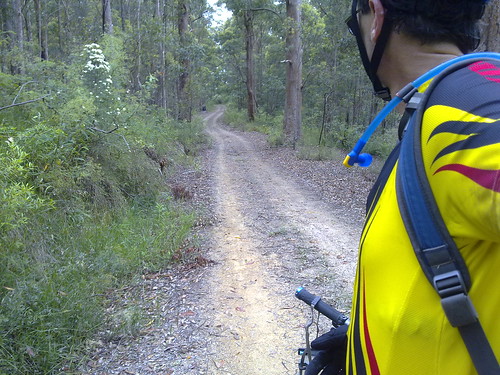
South Boundary Road is a beautiful track which runs from Mount Nebo to The Gap and passes through lush rainforest and open eucalypt bush land. On any weekend it’s a free-way for mountain bikers 🙂
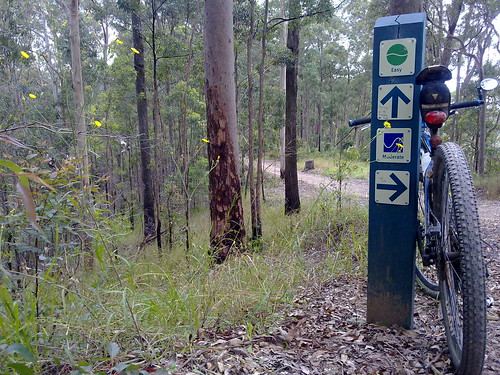
Lots of trails branch out from South Boundary Road. Even with a GPS I missed one turn – the same turn I missed last time. Thankfully there are lots of signposts to show the way.

The southern end of Brisbane Forest Park borders Mt Coot-tha forest, which has been set aside by the Brisbane City Council.
It has miles of trails to ride as well.
I couldn’t resist leaning the bike up against a large spotted gum and taking a picture of this old wrought iron gate in the middle of nowhere.
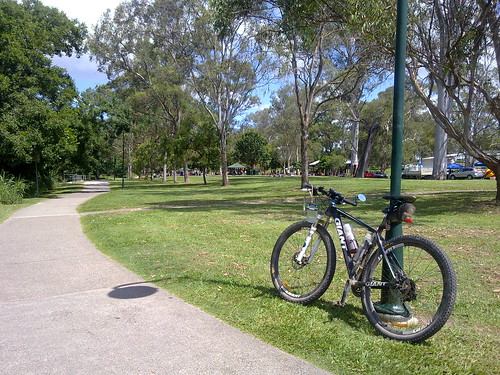
After leaving the forests of the D’Aguilar Range I headed east towards the coast.
Thankfully most of the way is via bike ways which go through the many parks that line the creeks on their way to the sea.
Kalinga Park is usually full of people enjoying a picnic lunch on a Saturday. Today was no exception
All up, 112km with 1750m of vertical ascent. 5,800 kcal burned. (That’s a lot of Gatorade :)).
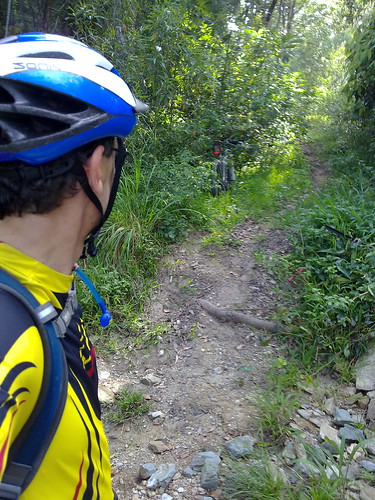
One of my favourite spots on the Dunlop Lane / Smiths Road loop is the Mosquito Creek crossing. It’s in the middle of several km of quiet bushland trails. When I first rode it, I had to dismount to complete the crossing, but these days I just zip across it on the bike and always feel smug about it 🙂

Another survey tree. It’s amazing how once you know what to look for, these trees just seem to pop up everywhere.
Surveyors “blazed” Iron Bark Eucalypts like this one, for use as survey markers, because the species is very slow growing. So a mark will remain relatively unchanged for decades. This one is probably almost 100 years old. I’ll update when I find out more info from our wonderful local history librarian.

A camel thinks she’s part of the herd. I stopped the bike and asked the camel if I could take her picture. The only reply I got was a very low grumble. Camels have attitude!
Ghost Train
Camp Mountain Railway
Mount Samson Railway
Samsonvale Railway
Dayboro Railway
The Bat Cave

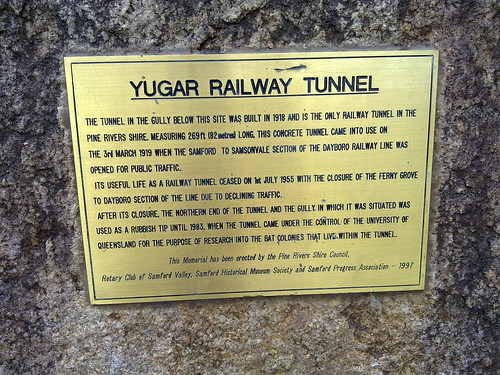
North of Samford, the railway line passes through Yugar. This is the only place on the line where a tunnel was necessary to pass under the roadway.
After the railway line was closed, this gully was used as a rubbish dump, but in 1983 the University of Queensland acquired the site to study the bats that now live in the tunnel.
Today my only other companion was a large hungry Brown Snake who was obviously looking for some bat-flavored fast food take-away!
As part of my project to explore the site of the old railway line between Ferny Grove and Dayboro I cycled out to Ferny Grove today. Today this is the terminus of the Queensland Railway’s Brisbane to Ferny line.
Ghost Train
Camp Mountain Railway
Mount Samson Railway
Samsonvale Railway
Dayboro Railway
The Bat Cave
But before 1955 this line went all the way to Dayboro.
The old railway track rises out of Ferny Grove and winds slowly up Camp Mountain. Even though the gradient is low (less than 5%) the train would have struggled slowly to the crest of the hill, after which it would pick up speed as it rolled down into Camp Mountain Station.

In May 1947, disaster struck. After reaching the top of climb at Camp Mountain, one train accelerated too quickly downhill and crashed at this site as the track curved sharply to the left.


16 people were killed as carriages telescoped into each other.
Today it still stands as Queensland’s worst ever rail disaster, and the second most tragic rail disaster in Australia’s history after Granville.

Wights Mountain has one of the best preserved Aboriginal Ceremonial Bora Grounds in our area.
I didn’t have a wide-angled camera, so I had to stitch the photos together. Can you make out the raised ring of earth?
The Bora Grounds consisted of one large ring in which important tribal ceremonies were conducted, and a second secret ring where young initiates were taken to learn “mens business”. The two rings are connected by a sacred pathway approximately 400m long.
As I stood by the large ring, I imagined what it would have been like to stand here hundreds of years ago in the firelight as the tribe sang their songs, and young boys became men – learning secrets handed down for generations.
I felt a sense of loss.
European history is almost clinical. It has been chronicled in books for centuries for anyone to read. Aboriginal history is different. To learn it you needed to have a relationship to the person telling it to you, and a personal commitment to the community. We’ll never know many of the stories and secrets told here – they died with the story tellers.
I’ve only photographed the larger ring. I didn’t think it was respectful to photograph the smaller ring. If you want to see that, you’ll need to go to Wights Mountain yourself!


Here’s a diorama at the Samford Historical Museum depicting how the Bora Ring would have been used by the local Aboriginal people.



There are several Marked Trees at the Bora Grounds. One of these is obviously a Government Survey Tree (marked with an “R” and a number). I’m not sure whether the other trees are survey trees, or have been “marked” by Aborigines to signify the importance of the site. I’ll update the information when I find out.
Just a couple of quick photos of the river this morning during my ride.
Sometimes I need to remind myself that I do live in paradise!